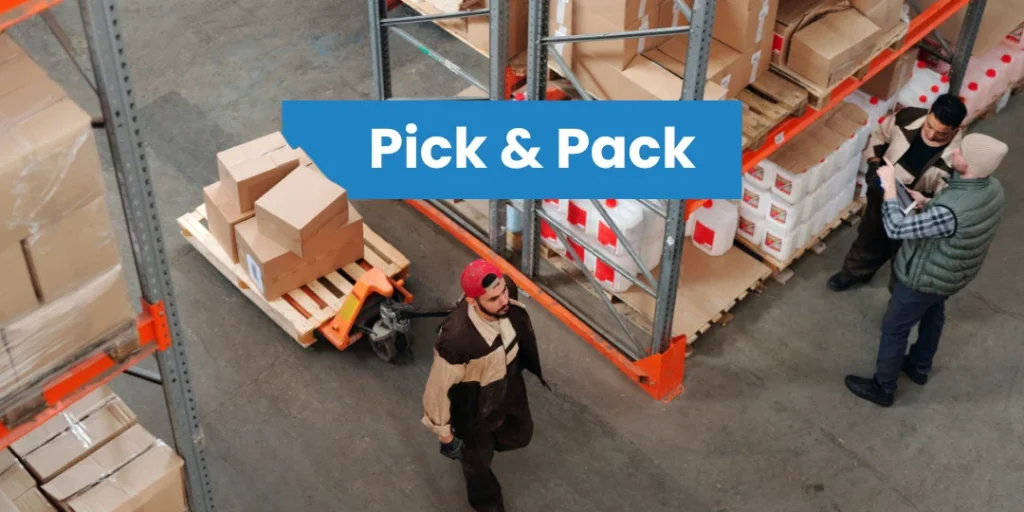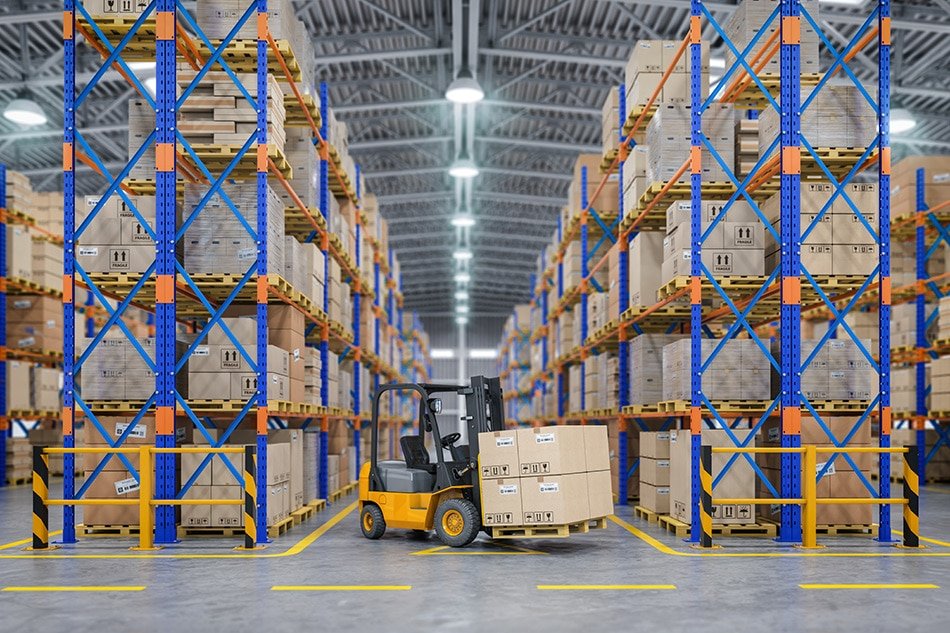The way businesses handle order fulfilment can make or break their success in today’s competitive e-commerce landscape. A pick and pack warehouse is more than just a storage space it’s a high-functioning engine designed to process, package, and ship orders quickly and accurately.
In an era where customers expect same-day or next-day delivery, the efficiency of a warehouse’s pick and pack operations directly affects customer satisfaction, brand reputation, and profitability. This system has gained even more attention with the rise of companies like Amazon, whose Amazon warehouse picking and packing methods have become an industry benchmark.
Whether you’re running a large fulfillment center or a small e-commerce business, understanding and mastering pick and pack operations is essential to staying competitive.
What Is a Pick and Pack Warehouse?
A pick and pack warehouse is a specialized type of fulfillment center designed to handle individual order preparation rather than bulk shipments. Instead of shipping pallets of goods to retailers, these warehouses pick products directly from inventory shelves as orders are placed, pack them securely, and ship them to the customer.
This system is ideal for:
-
E-commerce businesses that deal with a large number of small orders.
-
Subscription box companies requiring customized product combinations.
-
Wholesale distributors serving multiple retail clients with varied needs.
The core value of a pick and pack warehouse lies in its ability to process orders quickly while minimizing errors.
How Pick and Pack Differs from Traditional Warehousing
While traditional warehouses focus on long-term storage and bulk distribution, pick and pack facilities are built for speed, flexibility, and direct-to-consumer fulfilment.
Key differences include:
-
Order Volume & Size – Traditional warehouses ship in pallets or large batches; pick and pack warehouses handle many small, individualized orders.
-
Processing Time – Bulk orders may take days or weeks; pick and pack aims for same-day or next-day shipping.
-
Technology Use – Pick and pack facilities rely heavily on Warehouse Management Systems (WMS), barcode scanners, and sometimes robotics to speed up order processing.
-
Customisation – Orders may be personalised or require specific packaging, unlike bulk shipments.
The Role of Pick and Pack in E-Commerce Fulfilment
Why Speed and Accuracy Matter in Online Retail
E-commerce has fundamentally shifted customer expectations. Today’s shoppers want:
-
Fast delivery (often within 24–48 hours)
-
Accurate orders without missing or incorrect items
-
Real-time tracking
A slow or error-prone warehouse can lead to:
-
Higher return rates
-
Negative reviews
-
Loss of repeat customers
For online sellers, especially in competitive markets, the efficiency of their pick and pack process directly impacts conversion rates and brand loyalty.

Amazon Warehouse Picking and Packing: A Benchmark for Efficiency
Amazon is the undisputed leader in e-commerce fulfilment. Their picking and packing process is built on three pillars:
-
Advanced technology – Automated conveyors, robots, and AI-based routing.
-
Optimised layouts – Items stored strategically to minimise walking distance.
-
Rigorous training – Employees are trained to meet strict accuracy and speed standards.
By studying Amazon’s methods, even smaller warehouses can adopt scaled-down strategies such as zone picking and real-time inventory tracking.
Core Components of a Pick and Pack Warehouse
Inventory Receiving and Storage
The journey of every order begins when products are received. Best practices include:
-
Inspection – Checking for damage or defects.
-
Labeling – Assigning barcodes or RFID tags for tracking.
-
Strategic storage – Placing high-demand items closer to packing stations.
Order Picking Methods
The way a warehouse picks items greatly impacts efficiency. Common methods include:
-
Batch Picking – Multiple orders picked together, reducing travel time.
-
Zone Picking – Workers assigned to specific warehouse zones.
-
Wave Picking – Orders grouped by shipping schedules.
Packing Stations and Quality Checks
A packing station is more than a table it’s the final checkpoint for order accuracy.
Quality control ensures the right items, correct quantities, and proper packaging materials are used to protect products during transit.
Best Practices for Pick and Pack Inventory Management
Inventory management is the foundation of an efficient pick and pack warehouse. Even with the fastest workers and advanced technology, poor inventory control can slow operations and increase costs.
Here are proven practices for optimising pick and pack inventory management:
Implementing Real-Time Inventory Tracking
Real-time inventory tracking ensures that stock levels are accurate at all times. A Warehouse Management System (WMS) integrated with barcode scanners or RFID tags can:
-
Update stock automatically when items are picked, packed, or received.
-
Prevent overselling by syncing with e-commerce platforms.
-
Reduce stockouts through automated reorder alerts.
This eliminates manual data entry, reducing human error and increasing efficiency.
Organising SKUs for Faster Retrieval
Product location can make or break picking speed. A smart SKU organisation strategy includes:
-
ABC classification – Placing high-volume products (A items) closest to picking areas.
-
Logical grouping – Storing related items together for bundled orders.
-
Vertical storage solutions – Using shelving or mezzanines to maximise floor space.
For example, in Amazon warehouse picking and packing, frequently purchased products are stored in multiple locations across the warehouse to reduce picker travel time.
Reducing Picking Errors Through Barcode and RFID Systems
Accuracy is as important as speed. Barcode and RFID technology help:
-
Verify items instantly during picking and packing.
-
Match products to orders automatically in WMS.
-
Reduce returns caused by incorrect shipments.
These systems pay for themselves quickly by lowering error rates and improving customer satisfaction.

Technology That Powers Modern Pick and Pack Warehouses
Modern pick and pack operations are driven by advanced technology. The right tools reduce labor costs, boost speed, and improve accuracy.
Warehouse Management Systems (WMS)
A WMS is the brain of the warehouse, handling:
-
Inventory control
-
Order routing
-
Staff allocation
-
Shipping integration
The best WMS platforms offer real-time dashboards and integrate with e-commerce stores, carriers, and accounting systems.
Robotics and Automation in Order Fulfilment
Robotics help solve labor shortages and increase efficiency by:
-
Transporting items to packing stations.
-
Automating repetitive tasks like sorting.
-
Working around the clock without fatigue.
For example, Amazon’s Kiva robots reduce the distance workers walk each day by up to 70%, greatly increasing productivity.
AI-Driven Demand Forecasting
Artificial intelligence analyses sales patterns, seasonal demand, and market trends to:
-
Predict order spikes
-
Plan staffing levels
-
Adjust inventory purchasing
This prevents overstocking and stockouts, saving both space and money.
Training and Workforce Optimisation
Your people are as important as your technology. Even the most advanced warehouse will struggle without a well-trained, motivated workforce.
Onboarding Pickers and Packers Effectively
A structured onboarding program should cover:
-
System training for WMS, scanners, and packing equipment.
-
Picking best practices for speed and accuracy.
-
Product knowledge for quick identification.
Role-playing and shadowing experienced workers help new hires gain confidence quickly.
Safety Protocols in High-Speed Fulfilment Centers
In a fast-paced environment, safety must come first. Key measures include:
-
Clear walkways and proper signage.
-
Ergonomic tools to reduce strain.
-
Regular safety drills for emergencies.
Safety not only protects employees but also reduces costly downtime from accidents.
Measuring and Improving Performance
To improve, you must measure. KPIs give you insight into efficiency, accuracy, and overall performance.
Key Performance Indicators (KPIs) for Pick and Pack Efficiency
Common KPIs include:
-
Orders picked per hour
-
Order accuracy rate
-
Average order cycle time
-
Return rate due to errors
Tracking these over time highlights trends and areas for improvement.
Continuous Improvement and Lean Warehousing
Lean principles eliminate waste and improve workflow. Examples include:
-
Minimizing travel distances
-
Standardising packing procedures
-
Rearranging layouts based on seasonal demand
Small tweaks can have a huge impact on speed and accuracy.
Case Study: Amazon’s Pick and Pack Operations
Lessons from Amazon Warehouse Picking and Packing
Amazon’s efficiency comes from:
-
Strategic product placement across multiple picking points.
-
Automated conveyors that move orders through the facility.
-
Real-time performance tracking for each worker.
Applying Amazon’s Principles to Small and Medium Businesses
You don’t need Amazon’s budget to improve. Start by:
-
Implementing a basic WMS.
-
Training staff in zone picking methods.
-
Using low-cost automation like conveyor belts or mobile barcode scanners.
Common Challenges in Pick and Pack Warehousing
Even the most efficient pick and pack warehouse faces operational hurdles. Recognizing these challenges early allows for proactive solutions that keep fulfilment smooth.
Seasonal Spikes and Scalability Issues
During peak seasons such as Black Friday, Cyber Monday, and Christmas, order volumes can skyrocket. Without proper planning, warehouses may face:
-
Order backlogs
-
Overworked staff
-
Increased error rates
Solution:
-
Hire seasonal staff and train them before peak periods.
-
Use temporary racking systems or mobile shelving for overflow inventory.
-
Implement a scalable WMS that can handle sudden data surges.
Returns Processing and Reverse Logistics
Returns are unavoidable in e-commerce, and poor handling can eat into profits. A disorganised return process leads to:
-
Lost or misplaced returned goods
-
Extended refund times
-
Dissatisfied customers
Solution:
-
Create a dedicated returns area in the warehouse.
-
Use WMS features to scan and process returns immediately.
-
Refurbish or restock returned items promptly to recover value.

Future Trends in Pick and Pack Warehousing
The fulfilment industry is evolving quickly, with technology and sustainability leading the way.
Drone Delivery and Automated Packing Solutions
In the near future, drone delivery could make same-day shipping the norm. Automated packing systems will:
-
Measure products and select optimal packaging.
-
Reduce waste by cutting excess filler material.
-
Increase speed by eliminating manual boxing for standard orders.
Sustainability and Eco-Friendly Packaging
As consumers become more environmentally conscious, warehouses are adopting:
-
Biodegradable packing materials
-
Right-size packaging to minimise wasted space
-
Recycling programs for cardboard and plastics
Not only does this appeal to customers, but it also reduces long-term material costs.
FAQs About Pick and Pack Warehousing
1. What is the difference between pick and pack and drop shipping?
Pick and pack involves storing inventory and fulfiling orders directly from your warehouse. Drop shipping ships orders directly from a supplier, without storing the product yourself.
2. How can I improve my warehouse picking speed?
Optimise storage layouts, use barcode scanners, train staff, and consider automation tools like conveyor belts.
3. What technology is essential for pick and pack warehouses?
A WMS, barcode or RFID systems, and automated picking aids like mobile carts or robots.
4. Is Amazon’s model achievable for small businesses?
Yes, by adapting the same principles such as real-time tracking and optimised storage but on a smaller scale.
5. What is the average picking accuracy rate?
High-performing warehouses aim for 99% or higher to minimize costly returns.
6. How does inventory management impact pick and pack efficiency?
Accurate inventory ensures fast picking, prevents overselling, and keeps customers satisfied.
Conclusion: Building a Smarter, Faster, and More Profitable Warehouse
A pick and pack warehouse is more than a place to store products — it’s a critical component of the modern e-commerce supply chain. By implementing:
-
Real-time inventory tracking
-
Optimized picking methods
-
Strategic technology investments
-
Strong workforce training



